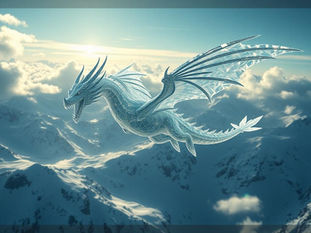
Get the Midjourney Images You Want: A Simple Guide to Better Prompts
Jun 9
5 min read
0
13
0

Are you using Midjourney but finding your images look a little... plain? Maybe you dream of specific scenes, characters, or styles, but Midjourney keeps giving you generic pictures. You're not alone! Midjourney often gives you nice but uninspired results if you don't tell it exactly what you're looking for. Think sunsets you've seen before or faces without personality. This guide will show you how to use prompts to get the unique images you imagine.
Why Your Midjourney Images Might Seem Generic
Midjourney learns from millions of images and matches pixel patterns to words. When you give it a prompt, it tries to make an image based on those matches. If your prompt isn't very specific, it falls back on what it sees most often in its training data. We call these "archetypes."
Midjourney defaults to these common patterns. If you just ask for "a forest," you'll get a typical forest image. If you want something special, you have to tell it.
Covering All the Basics
For Midjourney to create a specific image, your prompt usually needs three main things:
Subject: What is the main thing you want to see?
Background: Where is the subject? What is around it?
Style: What kind of picture should it be? (e.g., painting, photo, cartoon, specific artist's style).
If you miss one of these, Midjourney will guess and fill in the blank using its default archetypes. This is why you might not get the image closest to your idea.
Getting specific images from Midjourney can take time and trial and error. For faster results and more control, you might look into tools that help automate and refine your prompts. Explore the Midjourney Automation Suite by TitanXT to see how it can streamline your creative process.
How Midjourney Creates Images
Understanding a little about how Midjourney works helps you write better prompts. Midjourney uses a process called diffusion. It doesn't start with a blank screen. It starts with visual noise, like static on a TV screen. This is called the "seed."
Midjourney refines this noise step-by-step. It makes tiny changes to the pixels over many steps. This refinement process is called denoising. Your prompt guides this denoising process. It tells Midjourney what pixel patterns (correlated to your words) it should aim for.
Midjourney refines the image based on its learned rules between words and pixel patterns. It keeps going until it runs out of steps or time set for your job. If it stops too early, the image might look blurry, incomplete, or have strange details mixed up. People sometimes call this blending or incoherence.
Improve Your Prompts: Use Clear, Visual Language
Not all words help Midjourney the same way. Some words have strong connections to pixel patterns; others don't. Words with strong connections are usually descriptive and visual. Think about what something *looks* like.
Avoid Words That Can Cause Problems
Some types of words can make your results unpredictable or unreliable because Midjourney doesn't have clear visual data for them:
Instructions, conversations, commands: Words like "make," "create an image of." Midjourney understands what you want from the main words, not the command word.
Jargon or technical terms: Specific camera settings like F-stop or shutter speed, or terms like "16K HDR." Midjourney can't fully simulate camera mechanics or display effects like a computer can. What does "F2.8" look like visually in training data? It might relate to photos taken with that setting, but also camera manuals or ads. This makes the connection unreliable.
Complex literary words: Words like "nevertheless," "foremost," "primarily." These words don't describe visual things.
Using only words that have clear visual meaning helps Midjourney use its processing time effectively. It's like giving it a clear map instead of a confused one.
Use Dense Visual Language
Instead of chaotic words, focus on dense visual language. These are words that are descriptive and visually vivid. Think about:
Textures (rough, smooth, shiny)
Colors (bright red, pale blue, metallic gold)
Shapes (spherical, jagged, flowing)
Materials (wood, metal, glass, silk)
Lighting (soft shadows, dramatic highlights, glowing)
If you can answer the question "What does it look like?" for a word, it's probably a good word for your prompt.
Archetypes vs. Specific Details
Sometimes, for common concepts, you don't need many words. Midjourney already has strong "archetypes" for things it sees often in its training data. For example, if you prompt "lumberjack," Midjourney likely knows what that looks like: a bearded man, a flannel shirt, boots, an axe. You don't need to list all those details.
This is "leaning into the archetype." It uses less processing time. But if you want a lumberjack who looks different – maybe clean-shaven, wearing a tracksuit, and holding a briefcase – you need to describe those *specific* details to override the archetype. This is sometimes called "anchoring" or "pinning" details.
You need to decide: Do you want the standard version (use the archetype word) or something unique (describe the differences)? Tools that help refine prompts can be useful here, allowing you to quickly test different levels of detail. The Midjourney Automation Suite from TitanXT offers features to help you experiment and find the right balance.
Sourcing Styles Visually
Putting specific camera metadata or technical terms in your prompt often doesn't make the image look the way you expect. These terms don't have reliable visual correlations.
However, referencing iconic photographic styles usually works very well. Midjourney *does* have strong visual patterns associated with:
Styles like Polaroid, Leica, or specific art movements.
Famous photographers (like Ansel Adams, borrowing from their visual approach).
Publications (like National Geographic Magazine, Vogue, CNN, Southern Living).
These references are much more powerful for setting a visual style than technical camera data. You can also use image URLs to directly influence the style based on a picture you provide.
Words and Concepts That Don't Translate Well
Still struggling? Here are a few more things Midjourney finds hard to interpret:
Negation: Phrases like "no hats" or "without trees" usually don't work. Midjourney focuses on *adding* concepts, not removing them. Mentioning something makes it *more* likely to appear, even if you say "no." It's better to just not mention what you don't want.
Temporal words: Words indicating sequence like "first," "second," "then," "after," "before." Midjourney creates the whole image at once.
Vague intensity words: Words like "slightly," "a little bit," "mostly," "barely," "almost." Midjourney struggles with subtle degrees.
Smells and Sounds: What does the "smell of fresh bread" or the "gentle hum of machinery" *look* like? Midjourney tries to find visual correlations, which can lead to unpredictable results.
A Note on Remixing
Remixing an image multiple times can sometimes degrade the picture quality. Details might become less sharp, and the overall structure can become blurred. While remixing is great for making small changes or exploring variations starting from an image, doing it too many times in a row on the same image can reduce clarity. You might need to upscale outside of Midjourney or start a new prompt if degradation becomes noticeable.
Experiment and Refine
The best way to get the images you want in Midjourney is to keep experimenting. Pay attention to what works and what doesn't. When a prompt isn't giving you the right results, look at the words you used. Are there chaotic tokens? Is it missing a key element like background or style? Are you trying to negate something? Try rewording with more visual language.
Mastering prompting takes practice. Tools like the Midjourney Automation Suite by TitanXT can help automate some of the prompting process and offer ways to quickly iterate on ideas. This lets you spend less time troubleshooting and more time creating.
Now you know some key ways to guide Midjourney beyond its default settings. Keep practicing, keep experimenting, and watch your unique visions come to life!






